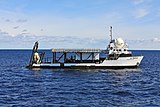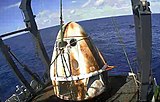Megan (ship)
 GO Searcher, one of SpaceX’s two recovery ships, is pictured in the Atlantic Ocean off the Florida coast while awaiting the splashdown of the company’s Crew Dragon spacecraft.
| |
| History | |
|---|---|
| Name |
|
| Owner | Guice Offshore |
| Operator | Guice Offshore |
| Builder | Master Boat Builders, Coden, Alabama |
| Launched | 2009 |
| Completed | 2010 |
| In service | 2010 |
| Identification |
|
| Status | In service |
| Notes | [1] |
| General characteristics | |
| Class and type | Platform supply vessel |
| Tonnage | |
| Length | 51.0 m (167 ft 4 in) |
| Beam | 12.0 m (39 ft 4 in) |
| Draught | 3 m (9 ft 10 in) |
| Depth | 3.6576 m (12 ft 0 in) |
| Decks | 1 |
| Installed power | 1,750 HP |
| Propulsion | 2 x CAT 3508B Industrial Diesel Engines |
| Speed | 22 knots (41 km/h; 25 mph) |
| Capacity | 32 |
| Crew | 6 |
| Notes | [1] |
GO Searcher is a SpaceX Dragon recovery vessel.[2] It is one of the offshore supply ships operated by Guice Offshore.[3] The other identical ship is GO Navigator.[4]
History
GO Searcher is the primary recovery vessel for the SpaceX Dragon/SpaceX Dragon 2 after the splashdown. Immediately after splashdown, fast small boats are launched to connect the capsule to the vessel, and the capsule is lifted on-board with the large lifting frame installed on the stern. The astronauts are now liberated, and NASA requires that this happens within 60 minutes of splashdown. Facilities onboard include a helipad, a medical treatment unit, and extensive radar communication equipment.[2][5]
Between April and May 2019, GO Searcher was temporarily re-assigned with GO Navigator to fairing recovery operations for the ArabSat-6A, and Starlink 0.9 missions.
On August 2, 2020, Robert L. Behnken and Douglas G. Hurley returned to Earth, landing in the Gulf of Mexico, off the coast of Pensacola, Fla. GO Searcher's sister ship, GO Navigator, pulled the capsule onto her aft, in which Behnken and Hurley exited the capsule.[6]
Incidents
- According to United States Coast Guard, on May 9, 2020, while practicing recovering the SpaceX Dragon 2 capsule, GO Searcher's crew pulled a man from the Atlantic Ocean.[7][8][9]
Gallery
- GO Searcher Gallery
-
GO Searcher, in the Atlantic Ocean, about 200 miles off Florida’s east coast, on March 8, 2019
-
SpaceX’s Crew Dragon Demo-1 spacecraft aboard the company’s recovery vessel, GO Searcher, following splashdown at 8:45 a.m. EST on March 8, 2019.
-
On August 13, 2019, NASA astronauts Doug Hurley, left, and Bob Behnken on GO Searcher, rehearsing Crew Dragon crew extraction with teams from NASA and SpaceX.
References
- ^ a b "Advanced Masterdata for the Vessel Go Searcher". VesselTracker. 2020. Retrieved 31 May 2020.
- ^ a b "GO Searcher". SpaceXFleet. Retrieved 2020-06-01.
- ^ "GO SEARCHER Offshore Support Vessel". intelligence.marinelink.com. Retrieved 2020-06-01.
- ^ "Crew Dragon Recovery". SpaceXFleet. Retrieved 2020-06-01.
- ^ "Go Searcher – Commercial Crew Program". blogs.nasa.gov. Retrieved 2020-06-01.
- ^ Chang, Kenneth (2020-08-02). "'Thanks for Flying SpaceX': NASA Astronauts Safely Splash Down After Journey From Orbit". The New York Times. ISSN 0362-4331. Retrieved 2020-08-05.
- ^ Mack, Eric. "SpaceX ship rescues boater while practicing for historic NASA mission off coast of Florida". CNET. Retrieved 2020-06-01.
- ^ Thompson, Amy (2020-05-10). "SpaceX recovery team rescues stranded boater during ocean recovery drills". TESLARATI. Retrieved 2020-06-01.
- ^ Speck, Emilee (2020-05-08). "Practicing retrieving astronaut spacecraft at sea, SpaceX vessel rescues stranded boater". WKMG. Retrieved 2020-06-01.



